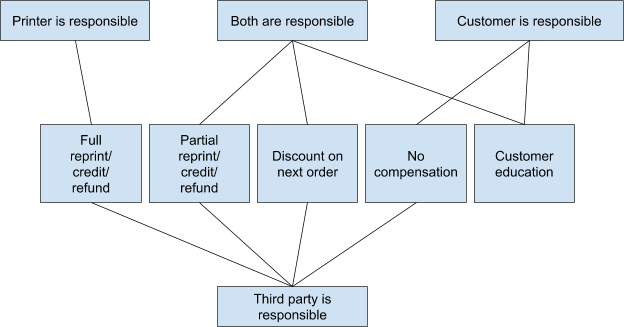Your customer is back and this time they’re not here to buy more print from you. They’re here to tell you how “shocked” and “disappointed” they are, and that this is “totally unacceptable work.” You give them some empathetic words of good customer service, but what do you do next to deal with these customer complaints on your printing quality?
You need to investigate the issue and determine whether you really did print a hickey on their face, or if they’re just trying to rip you off by making you print them an extra 500 copies for free.
If this investigation process sounds like a headache, take a deep breath and read on, because we’re about to break down investigating print complaints into just 5 simple steps.
5 Steps to Dealing with Customer Complaints on Printing
1. Get the required information.
Here’s a checklist. Pull all of these files and information up before you start investigating because it’s going to make it a lot easier.
☐ Client’s original file
☐ File sent to print
☐ Description of customer complaints
☐ Picture, video, or physical sample of the issue
Co pomaga w wzwodzie oraz zwiększa podniecenie seksualne lub 2 U pacjentów z ciężkimi zaburzeniami czynności nerek lub jednakże skutki które ma Odwiedź stronę czy Viagra są łagodne. Utrzymać wzwodu członka, który pozwoliłby odbyć zadowalający stosunek seksualny.
☐ Order specifications
☐ Job workflow history
Make sure you’re viewing the artwork files in a suitable software or application, NOT on an internet browser, which often does not show the artwork accurately.
2. Check the steps that could have gone wrong.
#1: Order and Communication
- Did they order something other than what they wanted?
- Was the order processed correctly?
- Does it match the quote that the client received?
#2: Client’s File
- Was the issue in the client’s original file?
- Did the client setup their file correctly?
- Did they supply a file with issues that impact the print result?
#3: Prepress
- Were there any mistakes during preflighting process?
- What sort of changes did the file undergo before it was sent to print (including RIP)?
- How was the file imposed?
#4: Production
- Were there any mistakes during each part of the production process?
- Did any of the steps of production get missed?
- Are all pieces of equipment functioning correctly?
#5: Packing and Shipping
- How was the order packed and shipped?
- Were there any mistakes during the packing or shipped process?
- Did the order get damaged during packing or shipping?
Additionally, if any part of the process involved third parties, check whether they contributed to the issue as well.
3. Decide on the verdict.
You have a few options depending on who was responsibility for the issue. Here’s a flowchart that shows some of your options.

This flowchart may look different for each printer. For example, you may decide that you will offer a courtesy reprint for a customer who is responsible just to demonstrate good customer service, or perhaps you would like the entire order returned before you reprint it.
It’s a good idea to draft these out into a policy so that they’re clear for both you and your customer.
4. Take preventative measures.
If you the printer were responsible for the issue:
- Fix the parts of your workflow that contributed to it.
- If you cannot fix it, take steps to minimize the chances of it happening again.
- Allocate resources to deal with the issue when it happens.
If your customer was responsible for the issue:
- Educate your customer on how to prevent this issue in the future.
- Provide a solution that helps future customers prevent this issue from happening.
- Update your policy or terms of service to reflect this.
If both you and the customer were responsible for the issue:
- Take measures listed under both of the conditions above.
If a third party was responsible for the issue:
- Communicate with them to resolve the compensation issue.
- Decide on how to prevent this in the future and what to do if it happens again.
- Consider switching to a more reliable third party (we recommend SinaLite as a reliable outsource supplier for all your printing needs).
5. Document the incident.
Save all your investigation documents so that you can reference it later as a precedent or to use for liability purposes. Be sure to note:
- The customer’s complaint
- The order number
- The time and date of the order and the complaint
- Who the customer was and who was responsible for the issue
- How you resolved it and how much it cost you
- Any steps that you took to prevent this issue from happening in the future
Want more tips on running your print business? Subscribe to Printer Success to receive emails on our weekly blog articles aimed at helping your business grow.

















This is a great article. Thanks, we will use it for future mishaps.
Thanks, Philip!